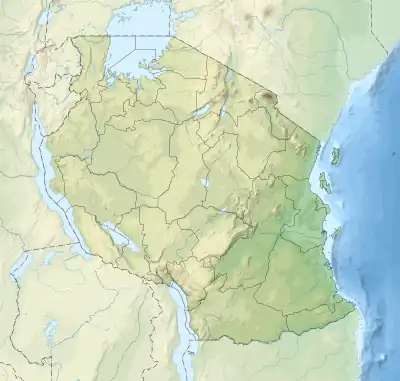Kaole
Kaole is a national historic site located in Bagamoyo District of Pwani Region in Tanzania. The site is located three miles east of the historic city of Bagamoyo on the Indian Ocean coast. The area contains old Swahili coral stone ruins dating to a period between the 13th century and the 16th century. Some of the ruins date back to the 13th century and consist of two mosques and 30 tombs.[2]
 Kaole Ruins in Bagamoyo District | |
 Shown within Tanzania | |
| Location | Bagamoyo District, Pwani Region, |
|---|---|
| Coordinates | 6.4634°S 38.9468°E |
| Type | Settlement |
| History | |
| Material | Coral rag |
| Founded | 13th century |
| Cultures | Swahili |
| Site notes | |
| Excavation dates | 1958 |
| Archaeologists | Neville Chittick |
| Condition | Endangered |
| Ownership | Tanzanian Government |
| Management | Antiquities Division, Ministry of Natural Resources and Tourism [1] |
| Architecture | |
| Architectural styles | Swahili |
| Official name | Kaole Ruins Historic Site |
| Type | Cultural |
The tombs at Kaole were built from coral stones with stone pillars that marked some of the tombs. According to local tradition, some of the tombs are the graves of local rulers who were known as "diwanis". "Diwanis" are believed to be the descendants of the Sheikh Ali Muhamad al-Hatim al-Barawi. A small museum has been established, where some artifacts are exposed that were found in the ruins. Some of these artifacts are Chinese and thus provide evidence of ancient commercial relationships.[3][4][5]
History
Kaole was originally settled in the 8th century as a trading town. Mangrove poles, sandalwood, ebony and ivory would have been the main trading items. The dwellings of the Kaole people were mostly constructed of wood, making them less durable than the stone mosques and tombs. Later on, the Zaramo people in the area called the place Kaole, meaning "go and see".[6] The first to study the Kaole Ruins was the British archaeologist Neville Chittick, around 1958.[3]
See also
References
- "Antiquities Division". Retrieved 21 Jul 2022.
- Pollard, Edward (2011). "Safeguarding Swahili trade in the fourteenth and fifteenth centuries: a unique navigational complex in south-east Tanzania". World Archaeology. 43 (3): 458–477. doi:10.1080/00438243.2011.608287. JSTOR 41308511. S2CID 161668324.
- "Kaole ruins". PlanetWare. Archived from the original on 16 July 2010.
- Bwasiri, Emmanuel J. (1 December 2011). "The challenge of managing intangible heritage: Problems in Tanzanian legislation and administration". South African Archaeological Bulletin. 66 (194): 129–135. JSTOR 23631415.
- Masele, Frank (2012). "Private Business Investments in Heritage Sites in Tanzania: Recent Developments and Challenges for Heritage Management". The African Archaeological Review. 29 (1): 51–65. doi:10.1007/s10437-012-9105-0. JSTOR 41486788. S2CID 161108176.
- Another place, south of Dar es Salaam, has a name with a similar origin: Gezaulole, meaning "try and see".


